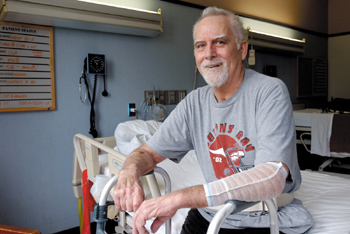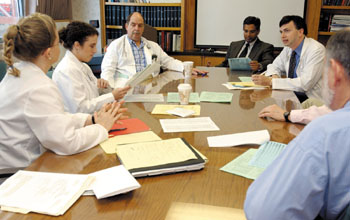
John Durdel, 59, received a lung transplant in January and will go home to Michigan this weekend after completing therapy at Stallworth Rehabilitation Hospital. (photo by Dana Johnson)
New era in transplants — 2003 on target to be best year ever for VUMC lung transplant program

The Lung Transplant program involves a large team of physicians, nurses, social workers, statisticians, exercise specialists, and transplant coordinators. (photo by Dana Johnson)
Vanderbilt University Medical Center’s Lung Transplant Program is moving full speed ahead, with efforts under way to make the program one of the nation’s busiest and most successful.
Dr. Mathew Ninan, assistant professor of Surgery in Cardiac and Thoracic Surgery and the program’s surgical director, and Dr. Aaron Milstone, assistant professor of Medicine in the Division of Allergy/Pulmonary & Critical Care Medicine and the program’s medical director, say they are proud to be leading a new era in lung transplantation at Vanderbilt.
The Lung Transplant Program performed 14 transplants in calendar year 2002, and has already performed nine transplants in the first quarter of 2003. Both 30-day and one-year survival rates for the program are well above the national average.
The average U.S. lung transplant center performs 11 transplants a year.
“The 30-day survival rate for lung transplants performed at Vanderbilt in the last 18 months is 91 percent, well above the national average,” Millstone said. The one-year predicted survival rate for Vanderbilt patients, for transplants performed over the last 30 months, is 84 percent, according to data kept by Hua Ye, the program’s data manager. Nationally, one-year survival rates for lung transplant patients, as measured by UNOS (the United Network for Organ Sharing), is 76 percent, Milstone said.
The Lung Transplant Program experienced some tough years in the late-90s with multiple turnovers of both medical and surgical directors, ebbing volumes of transplants and negative ramifications upon the program’s finances and contracts.
After the number of lung transplants performed at VUMC ebbed to the point of low single digits in the late-90s, Milstone and Ninan were asked by Dr. C. Wright Pinson, H. William Scott Professor and Chairman of the Department of Surgery and surgical director of the Vanderbilt Transplant Center, to assume the task of restoring the Lung Transplant Program to its previous status. At Pinson’s suggestion the two physicians sought help from the Center for Clinical Improvement that helped with redesigning the program. Both say the assistance offered was vital to the program’s renewed resurgence. “We are particularly grateful to Ted Speroff, Ph.D., Pat Throop, R.N. and her entire team,” Pinson said. “This CCI design project was a success.”
One of the reasons for the program’s success is intensive teamwork, said Haley Hoy, R.N., lung transplant coordinator, and that assessment was echoed by Millstone.
“That’s the result of medicine and surgery working together every step of the way,” he said. “We round three times a day on each of our patients, as well as being on call 24/7.”
“Lung transplants are among the most difficult of solid organ transplants to perform,” Ninan said. “The procedure itself is technically challenging but that’s not the only issue. The larger issue is choosing the right donor organs and the right patients, and then carefully managing them post-operatively. The care of these patients poses a heavy burden on people who do this work.”
Milstone says that on average one-third of the Lung Transplant Program’s patients require either him, Ninan, or one of the program’s two transplant pulmonologists, Dr. James Loyd, professor of Medicine in Allergy/Pulmonary & Critical Medicine, and Dr. Lisa Lancaster, assistant professor of Medicine in Allergy/Pulmonary & Critical Care Medicine, to make frequent trips to the hospital in the middle of the night and on weekends to manage patients’ needs.
VUMC offers patients a highly specialized center for the care of a wide array of pulmonary diseases such as cystic fibrosis, primary pulmonary hypertension and pulmonary fibrosis. These diseases are primary in the indication of lung transplantation. The Lung Transplant Program at VUMC offers a necessary complement to the treatment of these devastating diseases.
Milstone says word of the Lung Transplant Program’s resurgence is beginning to travel, and because of recent success with short wait times to transplantation and high survival rates, VUMC is beginning to receive referral calls from outside the Southeast.
Ninan and Milstone have set a goal of performing 20 lung transplants for this calendar year.
“To restore the Lung Transplant Program to its former glory has truly been an all-inclusive effort for the last three years,” said Milstone. “Before Matt (Ninan) came on board, the Lung Transplant Program was performing the lowest number of transplants since the early-90s. We did seven transplants during Matt’s first year here. It was one of the lowest volumes of transplants in the history of the program. We set out with the determination to do two things: to improve outcomes both at 30 days and at one year, and to substantially increase the number of transplants.”
The renewed success of the Lung Transplant Program is the result of a large team of health care professionals, Pinson says, including long-term program social worker, Dan Ramage and program secretary, Marie Phelan, all working with physicians to provide the comprehensive care necessary to bring patients to transplantation, through surgery, and then return them to a normal quality of life. In addition to physicians and staff directly involved in lung transplantation, the program receives invaluable support from the division of Infectious Diseases, the department of Pathology, the staff of the Kim Dayani Center, and VUMC’s Back to Work Program.
“It truly is a team approach to provide the patient’s care,” said Milstone. “It requires an enormous effort to bring a patient from pre-surgery to post-operative success.”
“Lung transplantation involves about 5 percent of my time as far as the actual surgeries, but management of these patients requires about 25 percent of my time. That’s the level of intensive treatment these patients need,” Ninan said.
There are only two lung transplant programs in Tennessee. The state’s only other program is at the University of Tennessee in Memphis. The Memphis program typically performs an average of 10 or fewer lung transplants each year.
“We believe it’s important for Tennesseans that Vanderbilt should be performing 30 to 40 transplants a year,” Milstone said.
To reach that goal the two physicians say it will be essential to recruit, train, and then retain the best staff.
For VUMC to reach the goal of transplanting 40 patients a year will require members of the transplant team to work as many as 80 nights a year. For every patient that receives a transplant there is a 50 percent turndown rate for donor lungs. So in addition to 40 completed procedures, a surgeon might spend as many as another 40 nights a year evaluating lungs that are then deemed unsuitable for transplantation.
Ninan says that in addition to the specialized care offered to patients, the Lung Transplant Program provides the necessary responsibility of an academic medical center’s mission to train the very best new cardiac-thoracic surgeons. Presently, two surgery residents are training to perform lung transplants. In addition to assisting with the success of VUMC’s program, these surgeons will then be able to offer lung transplantation to their patients wherever they may practice.
“We have set out goals for the future of increased volume in part through collaboration with the growing Lung Volume Reduction Surgery Program and the Lung Failure Program, excellence results, cost effectiveness, increased research and teaching,” Pinson said.
Ninan and Milstone say they are eager to take VUMC’s Lung Transplant Program to the next level with the goal of making it one of the dominant programs in the Southeast. But the two say it will require the involvement of interested individuals at VUMC through collaboration, and outside community support to increase the program’s visibility.
“We are a very large institution with a large faculty who are advanced in their areas of expertise,” Ninan said. “We want people here to know what we are doing, so if they are interested in research collaboration or other opportunities that would benefit lung transplantation or their research we would like to hear from them.”
Pinson is eager to put the accomplishments in lung transplantation in the context of the transplant program as a whole.
“The lung transplantation program, as well as all the other transplant programs, are doing very well these days in terms of growing volumes and excellent results,” said Pinson. He notes the significant increase in kidney, liver, pancreas, and heart transplants performed this past year, too.
“The transplant center is practically a beehive with activity right now. We are going to need space for all this program growth soon. Everyone is working harder and smarter to get these superb results, and our local organ procurement organization has done a fine job as well providing us organs to work with.”
Michigan man’s life saved through program
by John Howser
John Durdel, 57, a father of four and resident of Traverse City, Mich., suffered with advanced familial idiopathic pulmonary fibrosis. Durdel was referred to VUMC’s Lung Transplant Program by the University of Michigan’s Lung Transplant Program because of much shorter wait times at VUMC.
Durdel’s father died at age 59 of the same inherited disease.
“I was too deep on the list at the University of Michigan and knew I had to do something because I wasn’t too long for this world if I didn’t,” said Durdel.
The director of Michigan’s program contacted VUMC’s Aaron Milstone saying he felt Durdel had the best chance for survival at Vanderbilt because of the short wait times to transplant and high survival statistics.
Within a matter of a few days Durdel was flown to VUMC for evaluation on a Wings of Mercy air ambulance. By the end of the day of his first visit he was on Vanderbilt’s transplant list, and was transplanted one month later on Jan. 29 of this year.
“Everyone here has taken very good care of me. I had a bout of rejection after transplant that caused some setbacks but the doctors, nurses, technicians and everyone else has been right with me, and has been great,” he said.
Durdel will go home as soon as he completes rehabilitation at Stallworth Rehabilitation Hospital.













